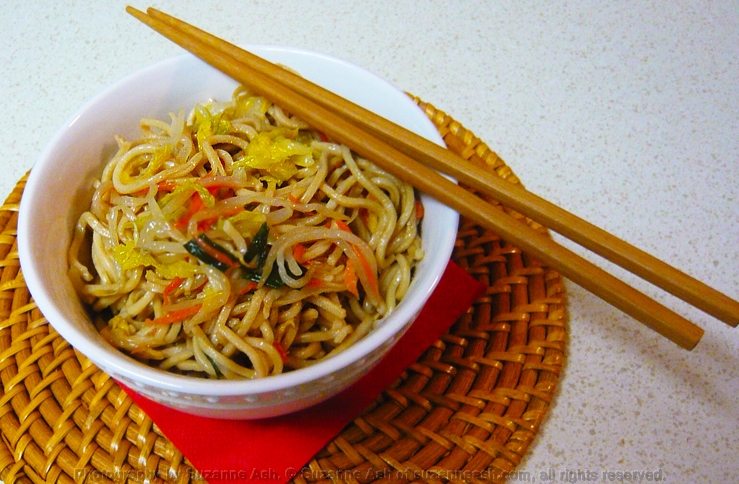
My recipe for this iconic Chinese dish is by no means authentic or traditional. It is, however, delicious, simple and filling. I’ve heard it called chow mein (apparently a US west coast thing) and lo mein (apparently a US east coast thing). Though I’ve eaten this fried noodle dish in 5 other countries (none of them China) and all of them called it Chow Mein. I also saw this little kit that I remember as a child. It’s a large can of sloppy vegetables in a sauce, and a small can of long cracker-like “noodles” you sprinkled over the top. It too was/is called chow mein. As far as I know, chow means ‘fried’ and mein means ‘noodles’, so maybe those little cracker noodles were fried?
Ingredients
The Sauce
- 3 TBSP oyster sauce
- 3 TBSP soy sauce
- 3 TBSP vermouth
- 1 TBSP sugar
- 1 TBSP cornstarch
- 1/4 tsp white pepper
- 1/4 tsp toasted sesame oil
The Rest
- 1 lb dry/uncooked low mein noodles (Chinese egg noodles)
- 1 to 2 TBSP light tasting oil
- Peanut or canola oil for frying
- 1 small Napa cabbage, sliced thinly
- Fine salt
- 2 cups fresh bean sprouts
- 1 carrot, grated
- 4 green onions, green parts sliced into 1″ strips
- 1 tsp of toasted sesame seeds (optional)
Instructions
IMPORTANT! The noodles need to be cooked, and cold before you use them. It’s best to do this the day before, or at least 4 hours before you want to make the dish.
• Cook the noodles according to the package directions. Once cooked, rinse in cold water and drain well. Place in a bowl or a zip-top bag and toss with 1 to 2 tablespoon of a light tasting oil. Peanut, canola, olive or even avocado oil work great. Make sure the noodles are well coated, but not dripping with oil. Refrigerate the noodles for at least a few hours, but overnight is better. The noodles need to be very cold or they will turn to mush when you fry them.
- When you are ready to make the dish, put all the sauce ingredients into a sturdy airtight/shakeable container such as a clean glass jar or you can put it into a measuring jug and whisk it. I find that a jar does a better job. Set the sauce aside until needed.
- Get your wok or very large heavy frying pan heating up over medium-high heat. Meanwhile, set out a large heat-proof bowl that is more than large enough to hold all the ingredients. Keep the bowl close to the wok as you cook.
- Once the wok (or frying pan) is very hot, add a little oil and then the cabbage. Sprinkle a little salt over the cabbage and keep it moving. Cook the cabbage until it has wilted but still has a little bite left to it. Remove the cabbage and put it in the bowl.
- Add a little more oil, then the bean sprouts and grated carrot to the wok. Stir-fry until they are hot but not wilted, add them to the bowl with the cabbage.
- Carefully wipe out the wok with some paper towels, if any small bits of vegetable remains. Get the wok hot again, but do not add any oil. Add the noodles in small batches and keep them moving. Stir-fry them just long enough to heat them through and start to get a little browned. Once they begin to brown, add them to the bowl of vegetables and do another small batch of noodles until all the noodles are cooked and in the bowl.
- Shake or whisk (depending on your choice of container) the sauce until the cornstarch is thoroughly blended into the liquid. Pour the sauce directly into the center of the hot wok and start stirring. Stir continuously until the sauce starts to thicken.
- When the sauce thickens up, turn off the heat and add all the contents of the bowl. Toss gently until everything is well coated in the sauce. Transfer to a serving bowl so to keep it from going mushy from the wok’s residual heat.
- Sprinkle with toasted sesame seeds just before serving.
Makes 6 Servings
Notes
- I do not suggest trying to make this recipe without oiling and cooling the noodles. You’ll end up with either a sticky mushy mass of noodles.
- Don’t worry, it’s not greasy at all if you follow the instructions. Don’t just dump a ton of oil in the noodles, start with 1 tablespoon and add more if needed. The noodles only just need to be coated enough to not stick to each other. The noodles in the picture look a bit shiny because they are cold. Also, I forgot to sprinkle mine with the sesame seeds and by the time I remembered I had already eaten it… yup, this stuff is awesome as cold leftovers!
- For a non-vegetarian version of this dish, just briefly stir-fry a cup or two of leftover meat or poultry before the vegetables, and add it to the bowl. Proceed with the recipe as written.
